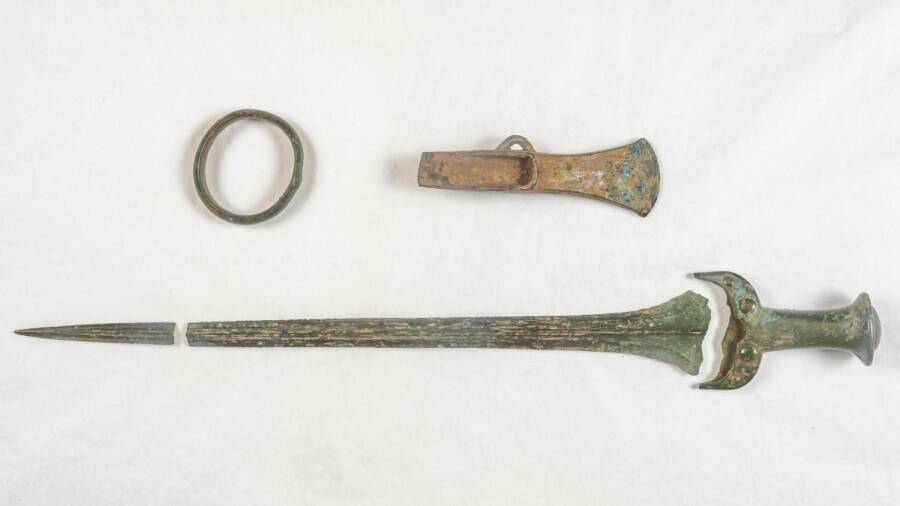After being separated from his group, John Belgrove went looking for high ground — and found a hoard of treasures dating back to around 1400 B.C.E.

Max Willcock/BNPSJohn Belgrove with the Bronze Age objects he discovered.
During a metal detecting rally in Dorset, a 60-year-old amateur metal detectorist by the name of John Belgrove got lost and separated from the rest of the group. As fortune would have it, though, Belgrove’s unexpected detour led him to the “find of a lifetime.”
Belgrove was heading toward high ground when his device suddenly activated, prompting him to start digging. What he found was astonishing: a collection of objects dating back to about 1400 B.C.E., including a rare rapier that had been deliberately broken into three pieces.
Only two similar swords have ever been found in Britain, both of which were incomplete. The find was considered to be of great historical importance, and multiple museums sought to add it to their collections.
How Getting Lost Led John Belgrove To Make The “Find Of A Lifetime”
Back in 2020, John Belgrove, a retired pensions consultant, joined a group of around 40 to 50 others in a treasure hunt on private farmland in Dorset, England. Per The Guardian, Belgrove paid £20 (around $25 U.S.) to join the small expedition.
“They had searched the land before but they were excited because some new land had been opened up for the rally,” Belgrove said. “I tagged along and didn’t know anyone there. Somehow I got left behind and lost and so I walked to high ground in a field and that is when I got a strong signal for this find of a lifetime.”

Max Willcock/BNPSThe ax head, rapier, and bracelet dating back to 1400 B.C.E.
Not expecting to find anything of great significance, Belgrove dug down about eight inches into the earth and found “an odd-shaped object that was caked in clay.”
“I didn’t know what it was at the time but it turned out to be a solid hilt of a sword, an exceptional item,” he said.
As he dug further, he found two broken pieces of the sword’s blade, as well as an ax head and a bangle.
“I knew when I saw the [ax] head that it was a Bronze Age hoard,” Belgrove said. “My head was in a spin. The blade of the sword was still sharp.”
Once word spread of Belgrove’s discovery, the British Museum decided they wanted it. However, the Dorset Museum and Art Gallery managed to raise £17,000 (around $21,700) to purchase the objects, with the money being split between Belgrove and the landowner. Now, roughly four years after its discovery, experts are sharing more details about the Bronze Age hoard.
Further Details About The Rare Bronze Age Rapier
At the time of the discovery, the blade of the sword was still sharp, with experts from the British Museum saying they believe it had been deliberately broken into three pieces and buried alongside a wealthy individual as part of a ritual offering.
In total, the rapier measures about two feet in length. Stangely, though the hilt was cast in bronze, it was shaped to resemble a wooden handle. It also surprisingly bears similarities to solid-cast hilts of Nordic swords found in Scandinavia, despite the Vikings not arriving in Britain for another 2,100 years after the rapier was made.

Max Willcock/BNPSThe unusual metal-cast hilt of the sword.
“This hoard is incredibly special. The rapier sword is really unusual because of the cast bronze handle. The bracelet decoration was quite unusual as well,” said Elizabeth Selby, director of collections at the Dorset Museum. “There aren’t really any comparable objects like the rapier, so to be able to acquire these items is really important for us.”
Selby noted that the Dorset Museum has plans to display Belgrove’s find in a special exhibition on treasure in the coming years, and that the objects will eventually be integrated into the museum’s permanent galleries.
“It’s incredible to think these beautiful objects of such skilled workmanship had lain buried in the Dorset mud for over 3000 years,” Belgrove added. “I am still pinching myself that I’m a part of the Stalbridge Hoard story.”
After reading about this remarkable discovery, read about the powerful Ulfberht swords of Viking culture. Or, read about the khopesh, the ancient sword that helped build the Egyptian Empire.





